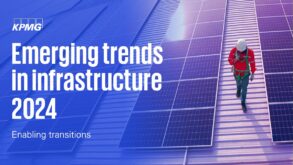
This is a sponsored message from KPMG.
All at one time, we want to change our energy mix, our climate, our economies, our global trade patterns, our cities, our technology and our social equity. And we plan to do it all against a backdrop of a non-stationary environment, divisive geopolitical rhetoric and deep economic uncertainty. It is a mammoth task.
Humanity’s success or failure will largely rest on the shoulders of our infrastructure. Infrastructure will be central to the energy transition and achieving our climate adaptation goals. It catalyzes economic growth and facilitates trade. It underpins urban renewal, lays the foundations for digital transformation and — when done well — can help embed social equity. It underpins urban renewal, lays the foundations for digital transformation and — done well — can help embed social equity.
To achieve this we need to change (and improve) the way we plan, fund, develop and operate our infrastructure. It will require collaboration, new funding mechanisms, innovative regulatory regimes, new construction techniques, broader skill sets and — more than anything — a high degree of flexibility and creativity. Enabling the world’s transitions, therefore, must start with a transition in the infrastructure sector.
This summary of KPMG’s 2024 Emerging Trends in Infrastructure highlights ten trends (see top three below) that KPMG professionals believe will shape the world of infrastructure in 2024.
Trend 1: A broader focus for the ‘Just Transition’
To date, much of the conversation around the ‘just transition’ has been focused on jobs. Yet the bigger challenge will be in ensuring that investment, development and sustainability outcomes are spread equitably between developed and emerging markets. Over the coming year, expect to see some governments and international organizations start to broaden the definition of ‘just transition’ and, with it, encourage greater collaboration between nations, sectors and citizens.
Trend 2: A turn in geopolitics
With collaboration, partnership and trust in short supply and geo-political and economic head winds dominating the headlines, the actual and perceived risks to businesses have grown multi-fold. This year, expect to see infrastructure players and investors focus on finding ways to measure, manage and mitigate the risk of uncertainty. KPMG is cautiously optimistic about the triumph of economics and good policies over protectionism and divisive short-term strategies.
Trend 3: The rise of philanthropic capital
The quantum of philanthropic capital being allocated to infrastructure development is rising. Working in partnership with MDBs and development agencies, these philanthropic investors are using their financial strength and different return expectations to help MDBs crowd more private sector capital into projects using forms of ‘blended finance’. Should they be successful, a greater volume of projects start to come to market — particularly in the emerging markets.
Read the full summary with all ten trends. To learn more about the topics raised in this report, contact your local KPMG member firm.

Discussion
Be the first to leave a comment.
You must be a member of the BuiltWorlds community to join the discussion.